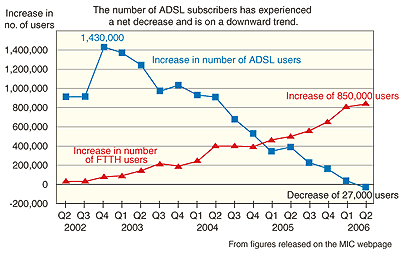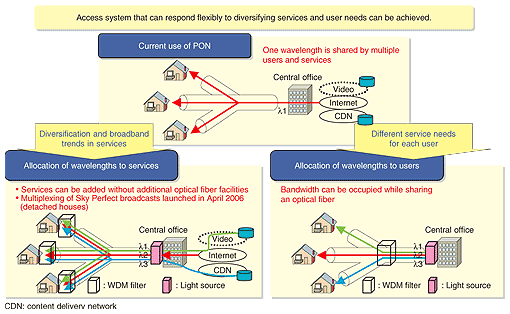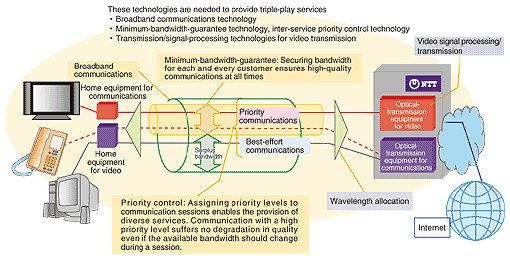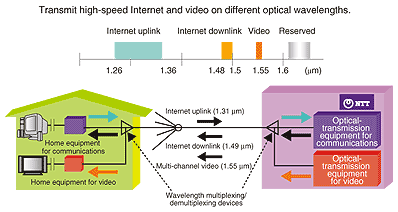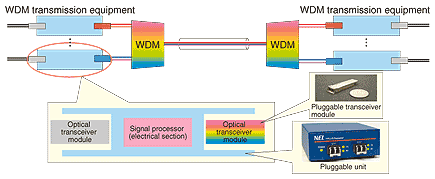 |
|||
|
|
|||
|
Special Feature: NTT Tsukuba Forum 2006 Workshop Lectures Vol. 5, No. 5, pp. 6–13, May 2007. https://doi.org/10.53829/ntr200705sf1 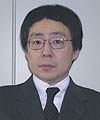 Trends in Optical Access Toward Enhancement of FTTH—Toward a Simple and Smart Optical Access NetworkAbstractThe number of fiber-to-the-home (FTTH) users has been increasing at a rapid rate and is expected to continue to rise in the years to come. At the same time, there is an accelerating trend toward diverse optical access services and complex user needs. Under these circumstances, the network of the future will have to become not only faster and more economical but also simpler and smarter. This article introduces trends in optical access technologies and describes activities and issues associated with the development of new optical access services.
1. Trends in broadband services1.1 Spread of broadband in JapanAccording to figures released by the Ministry of Internal Affairs and Communications (MIC), the number of new ADSL (asymmetric digital subscriber line) subscribers per quarter peaked in the 4th quarter of 2002 (1,430,000 new subscribers) and began to decrease after that. And in the 2nd quarter of 2006, a net decrease of 27,000 subscribers was recorded for the first time since those services began. In contrast to this downward trend for ADSL, the number of new subscribers to FTTH (fiber to the home) continues to increase, reaching a record of 850,000 new users in the 2nd quarter of 2006 (Fig. 1). This decline in ADSL appears to be most prominent in urban centers. Although there are still some regions where the use of ADSL is actually increasing, the trend toward fewer new ADSL subscribers is expected in those regions as well. As of June 2006, the number of ADSL subscribers stood at 14,490,000 compared with 6,310,000 FTTH subscribers.
In a survey comparing broadband service rates in Japan with those in various other countries, Japan's rate of US$0.07 per 100 kbit/s (as of December 2004) was found to be the least expensive in the world. Nevertheless, many problems still remain in relation to the "digital divide" (information gap). First, in terms of the gap between generations, the rate of conversion to broadband has nearly leveled off, and the gap between generations in this regard is small. However, a large percentage of the people that actually use broadband-connection services is made up of young people while the usage rate by people in their 50s and over is low. Since usage by young people has increased dramatically in these last few years, this gap in usage between the younger and older generations is on the rise. Next, in terms of a regional gap, the broadband usage rate tends to be higher in urban areas. An examination of the level of broadband provision according to urban scale found that penetration was running at nearly 100% in municipalities with populations of 10,000 people or more, including those that responded that subscription is not possible in some areas. However, slightly under 10% of small municipalities with populations under 10,000 people (1465 municipal bodies) said that subscription is not possible in all areas (FY2006 information-communications white paper). 1.2 Trends for overseas telecommunication carriers and activities in NTT LaboratoriesTelecommunication carriers in various countries are actively pursuing the deployment of optical-fiber network facilities based on individual business models. For example, AT&T's "Project Lightspeed" initiative will provide data and IPTV (Internet protocol television) by fiber-to-the-node (FTTN) and fiber-to-the-premises (FTTP) schemes. The company aims to provide these services to about 18 million households in 13 states by 2008, which means they are going up against giant and powerful cable-TV companies. Here, FTTN means optical fiber deployed from the exchange to network nodes and DSL (digital subscriber line) connections from the nodes to user premises. This configuration can provide the user with high-speed and low-priced services. The FTTP scheme is a network-circuit configuration that is now expanding with a focus on new residential developments. Verizon, meanwhile, is working to increase its FTTP coverage to up to 6 million households by the end of 2008 through the provision of FiOS optical broadband services and FiOS-TV video delivery services based on three-wave multiplexing technology. Against this background of worldwide expansion of optical broadband services, NTT Access Network Service Systems Laboratories is actively promoting international collaboration activities. Its main objective in these activities is to unify interface specifications and establish international standards to bring down costs on a global level. To this end, Access Network Service Systems Laboratories is energetically participating in discussions at ITU-T, FSAN, and IEEE on service requirements and system specifications. For example, NTT has been active at FSAN (Full Service Access Network) as a central member since its founding in 1995. FSAN is an organization that aims to reduce purchasing costs by establishing common international specifications for the deployment of optical access systems. Based on requirements provided from carriers who have concerns about the deployment of optical access systems, FSAN prepares pre-standards and pre-specifications through a cooperative relationship with manufacturers and conducts compatibility tests. Specifications prepared in this way may become international standards, as in the case of ITU-T G.983 (B-PON). 2. Optical access technologies2.1 Access network formatThe access network that connects the central office with the customer's house is divided into the following three facility configurations listed in order of proximity to the central office:
In terms of distribution, FTTH physical connections can be broadly divided into two formats: single star (SS) featuring a 1-to-1 connection between the central office and each customer's house and double star (DS) featuring a single OLT shared by multiple customers and 1-to-N connections between the central office and customer houses. The DS format can be further divided into active double star (ADS), which places active equipment in an intermediate position and performs branching to multiple customers, and passive double star (PDS), which uses a splitter to physically divide an optical signal. The PDS-based network, or passive optical network (PON), is becoming the basic configuration for the FTTH service now being promoted by NTT. Much progress has been made with PON systems in the pursuit of higher speeds and more economical transmission equipment. Past developments include synchronous transfer mode PON (STM-PON) and broadband PON (B-PON), but the most advanced version at present is Gigabit Ethernet PON (GE-PON), which combines a PON with Ethernet technology. Among the various FLET'S services developed by NTT, those that are configured in the SS format are the Business Type for corporate users, Basic Type for SOHO (small office home office) and individual users, and Mansion Type for residents in apartment buildings (called multi-dwelling units in this context). The Hyper Family Type and Hikari Premium services for detached houses use the GE-PON format. A GE-PON system offers uplink/downlink speeds of 1 Gbit/s and features a 4-branch splitter inside the NTT central office and an 8-branch splitter outside it close to the customers to provide a configuration accommodating a total of 32 users. 2.2 WDM technology for system expansionThe GE-PON format uses wavelength division multiplexing (WDM) as a multiplexing scheme for both the uplink and downlink. In a conventional PON, a single wavelength is shared by multiple users and multiple services (video, Internet, content delivery, etc.). However, as services are becoming more diversified and user needs more complex, it was decided to introduce WDM from the B-PON stage onwards as an optical access system that could handle these changes in a more flexible manner (Fig. 2).
Allocating a wavelength for each type of service is an effective way of coping with the trend toward diverse and broadband services. It will allow a customer that would like to add a new service to receive that service without us having to add new optical fiber. A case in point is optical-wavelength-multiplexed broadcasting developed in cooperation with Sky Perfect Communications Inc. Optical-wavelength-multiplexed broadcasting services were first offered to multi-dwelling units and began to be offered to detached houses in April 2006. In addition, by allocating a different wavelength to each user, we can meet needs that differ from one user to the next. In this case, a WDM filter must be placed between the central office and customer houses to achieve a configuration that enables bandwidth to be secured while sharing optical fiber. 3. Technologies supporting triple-play services3.1 Access technologies for providing triple-play servicesInternet connection, IP-telephony, and broadband video are three services that have, until now, required separate lines and facilities to be provided. The following technologies are needed to provide these services all on one line (Fig. 3).
(1) Broadband communications technology (2) Minimum-bandwidth-guarantee technology, inter-service priority control technology (3) Transmission/signal-processing technologies for video transmission The GE-PON system can satisfy these needs. The following outlines the technologies that can be achieved by GE-PON. 3.2 Broadband communications technologyThe GE-PON system, which utilizes the IEEE802.3ah standard (also known as Ethernet in the first mile) as an access system, achieves a transmission capacity of 1 Gbit/s in both the uplink and downlink directions. This large capacity enables GE-PON to satisfy future broadband demands and secure broadband access paths. The use of this standard also means significant cost reductions since equipment and components readily available in the large Ethernet market can be used. In the downlink, from the OLT to optical network units (ONUs) located at customer houses, all the ONUs receive the same signal. A particular ONU selects only those frames destined for itself and ignores frames destined for other ONUs. In the uplink, from ONUs to the OLT, each ONU is ready to send out frames at arbitrary times. Therefore, to prevent collisions from occurring at the point where ONU lines merge, the frame-submission process is controlled by having ONUs send out their frames in accordance with transmission permissions received from the OLT. 3.3 Precise bandwidth controlBandwidth must be flexibly controlled to maximize its use. The GE-PON system divides bandwidth up dynamically according to current usage conditions on each access line so that the uplink bandwidth can be controlled in a fair manner and so that a minimum bandwidth can be secured on each line (dynamic bandwidth allocation). In addition, priority control in the GE-PON enables priority to be given to forms of communication like audio and video that are sensitive to delays. Customers are asked to make separate settings for maximum speed and guaranteed speed (minimum speed) beforehand. If the network traffic is low, a customer can utilize a bandwidth within this range. If the network is congested, however, the 1-Gbit/s bandwidth will be shared among multiple users without any user dropping below the guaranteed speed. The surplus bandwidth can be allocated by either a fair allocation or weighted allocation scheme. 3.4 Transmission/signal-processing technologies for video transmissionUsing different wavelengths for each service makes it possible to transmit high-speed Internet and video services at the same time. Here, the 1.31-µm and 1.49-µm bands are used for Internet transmissions on the uplink and downlink, respectively, and the 1.55-µm band is used for multi-channel video broadcasts. Wavelength multiplexing is performed at the central office and a wavelength-demultiplexing mechanism is provided at the customer's house (Fig. 4).
Video transmission systems come in two main types: the AM direct-transmission system and the FM conversion system. The AM (amplitude modulation) direct-transmission system transmits a frequency-multiplexed signal directly. This has the advantage of simplifying the transmitter/receiver structure. On the other hand, this system is sensitive to noise, which means that multi-point distribution of the optical signal is difficult and that transmission distortion can easily occur. This system consequently requires a high-performance optical amplifier. The FM (frequency modulation) conversion system converts the frequency-multiplexed signal into an FM signal before transmission. This conversion process makes the transmitter/receiver structure somewhat more complex but makes the system robust to noise and transmission distortion. This has the advantage of facilitating reception at multiple points and enabling inexpensive optical amplifiers to be used. Furthermore, the FM conversion system does not require special angle-polished connectors, which are required for the AM direct-transmission system. 4. Trends in WDM access technology research4.1 Approach to expanding wavelength useA demand for even higher speeds in the optical access system is expected. The key to the next-generation access system as a successor to GE-PON is considered to be WDM technology. In existing WDM equipment, the signal processing section (electrical section) and wavelengths (optical section) are integrated: if the target wavelength changes, a separate package must be provided. This situation has led to two major problems: 1) many varieties of hardware are produced in small quantities and 2) optical-modules have different specifications. Improvements are needed in both cases. To expand the use of wavelengths, NTT has been pursuing greater economy through the use of pluggable modules and flexibility and ease of use through the use of colorless ONUs. The former has already been achieved while the latter is in the development stage. 4.2 Pluggable modulesThe optical section can be given common specifications by separating the signal processing section (electrical section) and wavelengths (optical section) in WDM transmission equipment (Fig. 5). In this new configuration, optical transceiver modules connect to both ends of a pluggable unit (signal processing section). This provides the following benefits:
Greater economy through simplified inventory management
4.3 Colorless ONUsAn effective way of making ONUs flexible and easy to use is to make them "colorless" whereby they detect or set the wavelength to be used automatically instead of being dependent on particular wavelengths. A configuration that enables selective use of wavelengths by OLT remote operation of a variable-wavelength transmitter on the uplink and a variable-wavelength filter on the downlink could enable a user to secure a large bidirectional bandwidth (in excess of 1 Gbit/s). 5. Trends in wiring technology development5.1 Development of efficient optical wiring methodsAccess Network Service Systems Laboratories is investigating design, construction, maintenance, and operation technologies for facilities located outside NTT premises toward the mass construction of optical circuits and the time when it will be necessary to maintain and operate a massive number of optical facilities. For example, some wiring methods will result in congested and inefficient wiring if demand should increase in the future. To avoid such a situation and achieve efficient facility construction, we are considering the following points.
5.2 Technologies for making optical wiring more efficient5.2.1 ClosuresFor outside closures, we have introduced modularized parts, developed connectors to simplify connections, and eliminated the need to store excess optical fiber. These measures have improved construction work by simplifying the tasks involved in protecting, connecting, and storing optical fiber and have improved operations by reducing the cutting and shortening of optical fiber and simplifying splicing. 5.2.2 Optical connector cabinetConventional optical cabinets include excess optical fiber requiring additional work and storage space. The need for storage space makes the cabinet larger, and field personnel must be skilled in the techniques required to process this excess bare fiber. In contrast, the new optical connector cabinet uses a cable-sheath-holding connector that enables a cable to be directly fitted with a connector. This has eliminated the need for processing excess optical fiber. In addition, the combined use of this cable-sheath-holding connector with highly bendable optical cable has enabled the cabinet volume to be reduced by 65% compared with the conventional cabinet, making for a very compact unit. 5.2.3. Free-bending optical fiber cordNTT has developed an optical fiber cord that is capable of carrying signals even in a bended, folded, or knotted state. This free-bending optical fiber cord enables optical wiring in a house to be laid out in a more attractive manner. 6. Access system operation6.1 Operation system for shortening service provision periodWe are entering an era in which the demand for optical connections will be commonplace. Measures must be developed to support optical services. To achieve NTT's goal of 30 million optical subscribers by 2010, we must shorten the time it takes to provide optical services. There are many processes that must be performed after a customer submits an application until actual provision of the service. While the time required for construction work can be shortened by introducing the new technologies described above, there is also a need to shorten the time required for processing an application and for determining and selecting the facilities needed. NTT Access Network Service Systems Laboratories is now in the process of developing and implementing a new operation system that aims to make the period up to optical-service provision no longer than that for an ordinary telephone line. 6.2 Construction of a correct and flexible systemThe optical access plant allocation system (PAS) provides automatic allocation of all facilities inside and outside the NTT office. This automatic allocation of all facilities can reduce labor, shorten the delivery time, improve system accuracy, and raise facility usage rate. The POS system is linked with other operation support systems to enhance workflow. The use of an operation log analysis tool can be effective in clarifying points that need to be improved in work related to access facilities. This tool can collect data from various operation logs (history) and use it to analyze current conditions from many aspects and determine the current state of the work process. It can also automatically extract points that need to be improved and perform simulations to evaluate the effects of improvement measures. In this way, feedback can be provided to operations to achieve a continuous cycle of improvement. In addition to developing technologies for improving work processes as described above, there is also a need to solve problems associated with the workflow management system itself. To this end, we are now performing studies on flexible process control (FPC) technology. In conventional systems, the frequent occurrence of exceptional work (atypical work) has the effect of lowering the overall average of work efficiency. Since it is unrealistic to analyze and implement all exception processing beforehand, our aim here is to achieve extreme flexibility that eliminates the need for prior design and implementation of exception processing. On the operations level, this approach has the benefits of adapting the execution order according to circumstances and achieving the minimum necessary range of corrections. Furthermore, as it eliminates the need for strict design and implementation of workflow beforehand, it can also reduce development costs. 7. ConclusionUntil recently, research and development of optical access networks has been focusing on ways of making the network more economical and faster. As a result, we now offer a 100-Mbit/s flat-rate FTTH service for 4000 yen per month. From here on, while continuing to pursue greater economy and faster processing in access facilities, NTT will also work to achieve a simple and smart optical access network. |
|||








